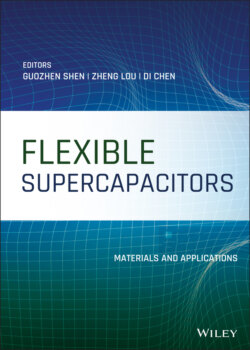Читать книгу Flexible Supercapacitors - Группа авторов - Страница 29
2.2.1.1 Fabrication of Stretchable Parallel SCs
ОглавлениеThe fabrication of stretchable, fiber‐shaped SCs with parallel structure is relatively easy. There are two typical ways to realize stretchability: one is by packaging the devices into stretchable substrate, another is by employing stretchable substrate or designing special structure, like screw spring, serpentine, etc. to implement it [53–55]. Figure 2.3a concretely displayed the first group of stretchable SCs by embedding the whole devices into pre‐strained stretchable substrate [56]. The CNT fibers, which were prepared by drawing and twisting CNT strips out of a vertically aligned CNTs array, were used as the wire‐shaped current collector. The highly aligned inner structures can provide both excellent mechanical properties and high electrical conductivity. Afterwards,(KMnO4) was used. Then, the two MnO2 coated CNT fibers were placed parallelly into pre‐strained stretchable substrate, after releasing, the stretchable fiber SCs were obtained with serpentine structures. Owing to the excellent electrochemical performance of MnO2 nanomaterials, the outstanding electrical conductivity of CNT fibers as well as the pre‐straining method, the fabricated fiber SCs showed a specific volumetric capacitance of ≈409.4 F cm−3 at 0.75 A cm−3at 40% of tensile strength. Figure 2.3b exhibited the cyclic voltammetry (CV) curves of the stretchable devices under stretching and folding, nearly invariable CV curves under different deformation state demonstrated the successful assembly of the stretchable fiber SCs. Although this method achieved the stretchability, the SC device itself did not live up to the conception of stretchability. Therefore, they always suffer from low tensile strength and poor stretching cycle stability.
Figure 2.3 Typical fabrication methods of 1D parallel fiber SCs: (a) Schematic illustration of the fabrication process of the fiber SCs by embedding in pre‐strained stretchable substrate, (b) CV curves of the stretchable devices under stretching and folding.
Source: Reproduced with permission [56]. © 2017, Wiley‐VCH.
(c) Schematic illustration of the fabrication process of the fiber SCs by twisting sandwich fiber with double side electrode, (d) CV curves measured during successive stretch, twist, release and untwist process.
Source: Reproduced with permission [57]. © 2016, American Chemical Society.
Different from the first embedded method, the second parallel SCs always employ the elastic materials as the stretchable substrate. In 2016, Choi et al. introduced stretchable SCs with sandwich fiber, the schematic illustration of the fabrication process was presented in Figure 2.3c [57]. The assembled method can be summarized as four steps: (i) Preparation of fiber shaped substrate. The dielectric silicone rubber (Ecoflex 0030) was processed as a sheet with a length of 30 mm by the conventional reaction of commercially available resins in a rectangular and then cut into ∼2 mm thick. (ii) Pre‐stretching the fiber shaped silicone rubber. The as‐prepared core fiber was stretched along the axial direction by 300% of its length. (iii) Covering electrode material on the surface of the core fiber. CNT aerogel sheets that extract from a multiwalled carbon nanotube (MWNT) forest served as electrode materials, which is attached on both sides of the silicone rubber fiber. The direction normal to the CNT electrode was coved with a PU film to prevent electrical shortage by residual CNT bundles during CNT wrapping. The strong adhesion between the CNT electrode and the silicone rubber fiber was guaranteed by continual dropping ethanol during CNT wrapping, which also protects the CNT surface from delamination. Then, the PU mask was mechanically removed from the silicone rubber fiber with CNT coat. 4: Release the fiber. The CNT electrode materials after release archived a uniform waved electrode. The electrical resistance of the CNT electrode materials is about 179 Ω cm−1 at the CNT loading of 2.31 mg cm−2 for each side, which is benefit to the electrochemical performances of the stretchable fiber SCs. Figure 2.3d showed the CV curves of the fiber SCs measured during successive stretch, twist, release and untwist process. Importantly, when applied a successive stretch, twist, release and untwist deformation during charge and discharge, the electrochemical performance of the fiber devices didn't change. The stretch test also showed an imperceptible nuance under various strains ranging from 0% to 200%.
